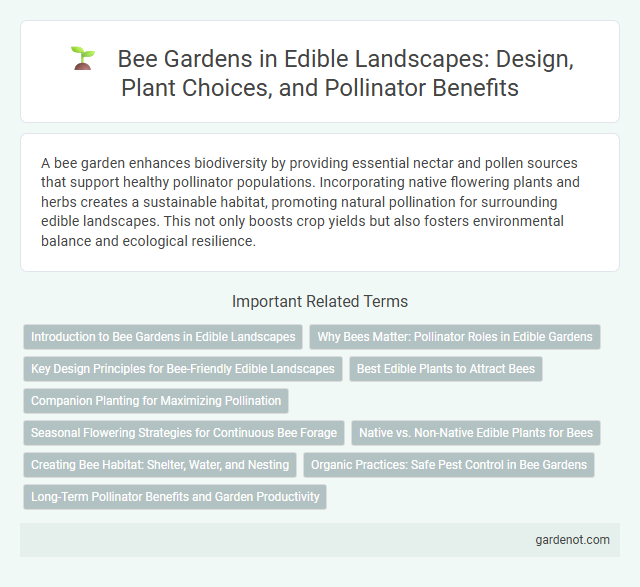A bee garden enhances biodiversity by providing essential nectar and pollen sources that support healthy pollinator populations. Incorporating native flowering plants and herbs creates a sustainable habitat, promoting natural pollination for surrounding edible landscapes. This not only boosts crop yields but also fosters environmental balance and ecological resilience.
Introduction to Bee Gardens in Edible Landscapes
Bee gardens designed within edible landscapes support pollinator health by integrating flowering plants, herbs, and vegetables crucial for bee nutrition. Strategic planting of native, nectar-rich species like lavender, clover, and sunflowers enhances pollination rates, improving fruit and vegetable yields. Maintaining diverse, pesticide-free habitats encourages bee population growth, essential for sustainable urban agriculture and ecosystem resilience.
Why Bees Matter: Pollinator Roles in Edible Gardens
Bees play a crucial role in edible landscapes by enhancing pollination, which directly increases fruit and vegetable yields. Their pollination activities improve the quality and quantity of crops such as tomatoes, cucumbers, and berries, making them vital for garden productivity. Supporting bee populations through bee gardens ensures biodiversity and sustains the natural pollination process essential for a healthy edible garden ecosystem.
Key Design Principles for Bee-Friendly Edible Landscapes
In creating bee-friendly edible landscapes, prioritizing diverse native flowering plants ensures continuous nectar and pollen sources throughout the growing season. Incorporating layered plant structures with varying bloom times supports different bee species and their foraging behaviors. Avoiding pesticide use and providing sheltered nesting sites further enhance the habitat's suitability for thriving pollinator populations.
Best Edible Plants to Attract Bees
Bee gardens thrive with bee-friendly edible plants like lavender, borage, and thyme, which provide abundant nectar and pollen. Fruit-bearing plants such as blueberries, strawberries, and sunflowers support bees while offering nutritious harvests. Herbs including sage, oregano, and chives enhance pollination and contribute to a productive edible landscape.
Companion Planting for Maximizing Pollination
Companion planting in bee gardens enhances pollination by strategically pairing flowering plants that attract diverse pollinator species, such as lavender alongside sunflowers and borage, which provide continuous bloom cycles and varied nectar sources. Incorporating native herbs like thyme and oregano supports local bee populations by offering high-quality pollen while simultaneously improving soil health and pest control. This synergistic planting approach increases fruit set and seed production, boosting overall garden productivity and biodiversity.
Seasonal Flowering Strategies for Continuous Bee Forage
Seasonal flowering strategies in a bee garden ensure continuous forage by planting a diverse array of bloom times, from early spring crocuses to late autumn asters. Incorporating native wildflowers, fruit trees, and herbs like lavender and thyme creates a staggered nectar flow that supports bee populations year-round. This deliberate planting maximizes pollen and nectar availability, enhancing pollination and promoting ecosystem health within the edible landscape.
Native vs. Non-Native Edible Plants for Bees
Native edible plants in a bee garden support local pollinators more effectively by providing familiar nectar and pollen sources critical for their life cycles. Non-native edible plants may offer additional forage but can sometimes compete with native species and disrupt established pollination networks. Prioritizing native plants such as goldenrod, bee balm, and native clover enhances biodiversity and sustains healthy bee populations in edible landscapes.
Creating Bee Habitat: Shelter, Water, and Nesting
Creating a thriving bee habitat involves incorporating diverse shelter options such as native flowering plants, hollow stems, and wood piles to provide safe nesting sites. Providing a clean water source like shallow dishes with stones supports hydration and efficient foraging. Strategic placement of these resources within an edible landscape enhances pollination, boosting the overall health and productivity of the garden.
Organic Practices: Safe Pest Control in Bee Gardens
Bee gardens thrive with organic practices that emphasize safe pest control methods, such as using neem oil, insecticidal soaps, and companion planting to deter harmful insects naturally. Maintaining diverse flowering plants supports beneficial pollinators and predator insects, fostering a balanced ecosystem that reduces the need for chemical interventions. Regular monitoring and handpicking pests further ensure the health of bees while preserving the integrity of the edible landscape.
Long-Term Pollinator Benefits and Garden Productivity
Integrating a bee garden within an edible landscape enhances long-term pollinator populations by providing continuous forage and habitat, which supports diverse native bee species. Increased pollinator activity directly boosts garden productivity through improved fruit and vegetable yields due to more effective pollination. Sustainable planting strategies focusing on native flowering plants and nesting sites create resilient ecosystems that promote ongoing pollinator health and food security.
Bee garden Infographic

 gardenot.com
gardenot.com